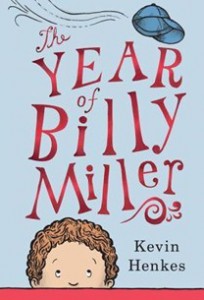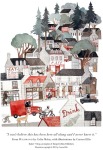It looks like Billy Miller might have a rough year. After all, right before he’s set to begin the school year an accident causes him to bang his head. Now, he not only has to start the year with a big bump on his head, but he’s worried that maybe his brains have been knocked around. What if he isn’t smart enough for the second grade? It turns out, of course, that Billy’s brain is just fine – but that doesn’t mean second grade is a breeze. Navigating school, family, and friends is tough and Billy doesn’t always have all the right answers. But with help from the people who love him, Billy finds that he can tackle it all.
Parents, children, and educators may be most familiar with Kevin Henkes for his work on adorable picture books like Lilly’s Purple Plastic Purse and Owen. In The Year of Billy Miller, Henkes creates a main character equally endearing, though decidedly less saccharine than his famous talking mice. Billy Miller is not a groundbreaking read – but what it lacks in originality it makes up for in authenticity. Billy Miller’s year is full of familiar elementary school concerns. Cancelled sleepovers, sibling rivalries, and the dreaded school diorama project will be familiar to parents and children alike; and Henkes treats them all with a lighthearted humor that still manages to acknowledge the seriousness with which youngsters take these issues. Billy is easy to like, and his family feels real enough to be believable, but quirky enough to be entertaining. The book is divided into four easy-to-digest sections with plentiful black-and-white art for those who are just starting to tackle chapter books, but Henkes doesn’t shy away from large vocabulary words that may daunt some hesitant readers. Henkes has once again provided an effort that proves to be a success, and one can’t help but wonder if we’ll see Billy Miller take on the third grade some day.
School Library Journal recommends this book for students in grades 1-3.
Publication Information: The Year of Billy Miller by Kevin Henkes. Greenwillow Books, September 2013. ISBN: 978-0062268129.
The above review is of an Advanced Reader’s Edition of this book sent to me by the publisher; artwork was not final and changes may have been made to the final text. I received no compensation for this review.
Every four years in the town of Gavaldon, two children disappear. They’re snatched by the mysterious School Master, never to be seen again.
Or, almost never.
Sometimes, the kidnapped children appear as daring knights, kind-hearted princesses, or evil villains in the illustrations of the fairy tale books that arrive – unasked for – at the town book shop. No one is quite sure what this means; except for town beauty, Sophie, that is. Although Sophie’s best friend – ugly, shy Agatha – tries to convince Sophie to do as the other children are doing and hide herself away on the evening of the School Master’s arrival, Sophie believes she knows her fate. Her beauty means she’s destined to be a fairy-tale princess, and she’s determined to be picked by the School Master and whisked away to live her destiny – even if it means hanging out the window in her best pink dress with homemade cookies as an offering. But when Sophie and Agatha both find themselves kidnapped and deposited at the School for Good and Evil to train for their fairy-tale debut, Sophie must learn that hard way that not every fairy-tale has a happy ending.

I can’t resist a school story for the back-to-school season, and The School for Good and Evil does not disappoint when it comes to boarding school high-jinx, cool classes, and good old-fashioned school rivalry. Where it does disappoint is in its pacing and repetition; the first half of the book is more than a little frustrating as Sophie and Agatha tackle the same challenge again, and again, and again…until they finally, every so slowly, realize what the reader has understood for chapters already; that Good and Evil are not black and white. The secondary characters – classmates and teachers alike – appear to be equally dim-witted about the realities of what beauty and ugliness really mean, and readers may start to wonder how the School for Good and Evil has managed to stay in business. However, readers who stick with the girls and make it through the first half are rewarded with all the excitement you’d expect a semester at magic fairy-tale school to entail; including magic competitions, back-stabbing villains, romantic entanglements, an epic final battle, and a surprise, cliff-hanger ending. For some, Chainani’s action-packed ending may not be enough to make up for a slow and frustrating introduction, but there are plenty of readers (myself included) who are willing to forgive the disappointing beginning in favor of the unique, magical story the author finally unfolds. Fans of fairy-tale retellings, lovers of fantasy, champions of strong female leads, and readers who wish they could return to that other magic boarding school will likely find themselves satisfied with Chainani’s offering, and cautiously optimistic about the April release of the book’s sequel, A World Without Princes.
School Library Journal recommends this book for students in grades 5-8.
Publication Information: The School for Good and Evil by Soman Chainani. HarperCollins, May 2013. ISBN: 978-0062104892.
The above review is of an Advanced Reader’s Edition of this book sent to me by the publisher; artwork was not final and changes may have been made to the final text. I received no compensation for this review.
Anyone who knows anything about anything knows that Jedi Master Yoda knows absolutely everything. So its no surprise that author Tom Angleberger’s middle grade novel features a pint-sized paper-folded version of the all-knowing Jedi.
Something strange is going on in the 6th grade. When dorky Dwight starts carrying around an origami Yoda finger puppet, everyone just assumes its another example of how strange the kid is. But Dwight insists that his origami Yoda has powers – and when Yoda starts predicting the future, catching petty thieves, and handing out good advice, a great debate begins in the 6th grade. Are Yoda’s powers real? Should his advice be followed? Tommy launches a scientific investigation to find out. Each student who has had encounters with Origami Yoda writes his or her own story – and shares his or her own opinion as to whether Yoda’s powers are real, or whether Dwight is making it all up.
Angleberger’s novel is a spot-on representation of the kind of fads that really can truly occupy the 6th grade mind for weeks at a time. Maybe its cootie catchers, maybe its M.A.S.H. games…maybe its origami finger puppets shaped like Star Wars characters. With authentic-sounding middle school voices, laugh-out-loud humor, and classic 6th grade situations, Origami Yoda is a fun read that’s bound to be a hit with the upper-elementary school set. The book’s look – with handwriting-style fonts, doodles in the margins, and pages designed to look like crumpled paper – will gain added points with fans of diary books like Wimpy Kid and Popularity Papers, and included instructions for folding your own origami Yoda make a nice bonus for parents or teachers trying to tie in a hands-on activity. For big fans, sequels abound – Darth Paper Strikes Back, The Secret of the Fortune Wookie, and an activity book titled Art2-D2’s Guide to Folding and Doodling.
School Library Journal recommends this book for students in grades 3-6.
Publication Information: The Strange Case of Origami Yoda by Tom Angleberger. Abrams, March 2010. ISBN: 978-0810984257.
It’s been a while since we’ve posted a Friday Book Review, so I thought I’d try to give you something that’s been worth the wait. And what could be a better reward after a long winter’s wait than the first two installments of Colin Meloy’s Wildwood Chronicles?
 In Wildwood, the first installment in the series, we meet Prue McKeel, an ordinary Portland girl whose life takes a strange turn when her little brother, Mac, is snatched up by a murder of crows and taken into the Impassable Wilderness – a strange and wild place on the outskirts of town that Prue has never known anyone to enter. Until now. Prue and her friend Curtis set out to find Mac and so begins the kind of strange and extraordinary adventure that features plucky children, talking animals, and evil sorceresses. With one adventure under their belts, the duo returns in Under Wildwood – along with a new cast of plucky children, talking animals, and evil magic-wielding adults – for another go. Both books are written in beautiful, simple prose and feature the sorts of lovable characters and daring adventures that will have readers making comparisons to the Chronicles of Narnia.
In Wildwood, the first installment in the series, we meet Prue McKeel, an ordinary Portland girl whose life takes a strange turn when her little brother, Mac, is snatched up by a murder of crows and taken into the Impassable Wilderness – a strange and wild place on the outskirts of town that Prue has never known anyone to enter. Until now. Prue and her friend Curtis set out to find Mac and so begins the kind of strange and extraordinary adventure that features plucky children, talking animals, and evil sorceresses. With one adventure under their belts, the duo returns in Under Wildwood – along with a new cast of plucky children, talking animals, and evil magic-wielding adults – for another go. Both books are written in beautiful, simple prose and feature the sorts of lovable characters and daring adventures that will have readers making comparisons to the Chronicles of Narnia.
If an engrossing story and classic writing style aren’t enough to draw you (or especially your child) to these admittedly very lengthy tomes (560 and 576 pages respectively in their hardcover editions), the beautiful art by Meloy’s award-winning illustrator wife Carson Ellis (famous for work on such modern classics as The Composer is Dead and The Mysterious Benedict Society) might just do the trick. Ellis’ illustrations are gorgeous, inventive, whimsical and absolutely perfectly suited to the tale they help tell.
- From Wildwood by Colin Meloy and Carson Ellis
- From Wildwood by Colin Meloy and Carson Ellis
- From Under Wildwood by Colin Meloy and Carson Ellis
- From Under Wildwood by Colin Meloy and Carson Ellis
- From Under Wildwood by Colin Meloy and Carson Ellis
- From Under Wildwood by Colin Meloy and Carson Ellis
Meloy and Ellis have collaborated to create a reading experience as magical as the wilderness they depict – and perhaps the greatest magic of all is the broad appeal of their books. This classic adventure story is perfect for a chapter-a-night bedtime read-aloud but is equally lovely for independent readers who wish to get lost in the wood with Prue and Curtis. The length will keep tweens satisfied that they aren’t being pitched a baby book, while the fact that Meloy also happens to be the front man of popular band The Decembrists will make hip teens and parents curious to take a look. None will be disappointed, and I would guess that nearly all will be anxiously awaiting their chance to return to Wildwood in the third installment.
School Library Journal recommends these books for students in grades 4-7.
Publication Information
Wildwood by Colin Meloy, illustrations by Carson Ellis. Balzer + Bray, August 2011. ISBN:978-0062024688
Under Wildwood by Colin Meloy, illustrations by Carson Ellis. Balzer + Bray, September 2012. ISBN: 978-006202471







